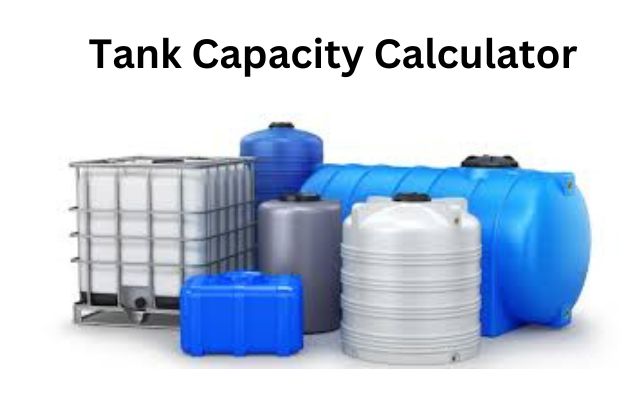Tank Capacity Calculator | Calculate Total Cubic Feets
Articles, products, and services offered on this site are for informational purposes only. We are part of the Amazon Services LLC Associates Program, an affiliate advertising program. Amazon.com is compensated for sales resulting from links on our website.
Please review our disclaimer before acting based on anything you read or see.
Using a tank size calculator, sometimes referred to as a tank capacity calculator, is a fast and simple method to convert your tank’s height, width, and length into a volume format. Just ensure you are utilizing the correct sizes and proportions. To aid you further, we have made this post.
The Tank Capacity Calculator is another useful tool that enables you to determine the volume of the tank (also known as the tank capacity), the volume of the liquid, and the volume of the liquid in the tank. Planning tank capacity for building projects, water purification facilities, oil storage solutions, and other things is made easier with the calculator.
Choose the tank’s design, enter the appropriate measurements, then click compute to see the outcomes to utilize the calculator. You can also enter the tank’s current liquid level to estimate the amount of liquid present and the percentage of the tank’s capacity that is being used. Use the interior dimensions of the tank while filling in the measurements. If they aren’t accessible, include the tank walls’ thickness in your volume estimates.
Overall, everyone should have access to this calculator. Follow along as we go into more detail about this below.
Tank Capacity Calculator
What is a Tank Capacity Calculator?
Using this simple tool, you can determine the tank’s and occupied portion’s volumes. You have a variety of tank shapes to pick from. The water tank’s form will determine the best approach for calculating tank capacity. However, keep in mind that they will be estimations. Your calculations will establish the tank’s volume, given a flawless, solid geometric form.
How to Calculate the Area of Tank Capacity
You may use the cylindrical tank surface morphology formula to get the tank capacity:
A = 2pr (r + h), where r is the radius of the base and h is the height of the cylindrical tank. You now understand how to determine a tank’s surface area. Use the tank capacity calculator if you need a simple calculating method to get a cylindrical tank’s surface area.
What is a Tank Capacity
Tanks are substantial spaces used to hold liquids. They are available in many different designs, such as rectangles, vertical cylinders, and horizontal cylinders. Their capabilities may be described in the following ways:

Nominal Capacity
This is the tank’s capacity when filled—calculated by adding the dimensions of length, breadth, and height.
Real Capacity
This is the maximum water level after subtracting the water lost while installing an overflow and warning pipe. If the top water level loss was 200mm, the whole height is reduced by that much.
Actual Usable Capacity
This is the volume of water that is physically accessible for usage in the tank before the air is introduced. It is determined between two datum locations: the diameter at the bottom of the tank, which is either the top of the outflow or the low-level switch and the top water level volume (see real capacity) (pump protection). This is often called “dead water” since it isn’t usable.
This can also be seen in the infographics below.
Why you need a Tank Capacity Calculator
You can quickly calculate the volume of your container with the tank capacity calculator. Choose from nine distinct tank forms, including elliptical and capsule tanks and the more common rectangular and cylindrical tanks. Cone bottom tanks may also be used to calculate a frustum’s volume. The total tank capacity will be calculated only by inputting the container’s specifications. To determine the filled volume, you may additionally provide the fill height.
Frequently Asked Questions
What is the volume formula?
V = l b h is the rectangular tank’s capacity formula. Here, “l” stands for the rectangular tank’s base’s length, “b” for its width, “h” for its height, and “V” for its capacity.
How do you convert volume to capacity?
The amount of space an item occupies in three dimensions is indicated by its volume. The term “capacity” describes something’s ability to contain, absorb, or receive an item (such as a solid material, gas, or liquid). Volume exists in both solid and hollow things. The capability only applies to hollow things. By combining each aspect and then translating it into the chosen volumetric units, you may convert volume to capacity.
What are the ways to calculate volume?
Following are some methods for calculating volume:
- Use space to calculate volume. Every physical item takes up space, and you may determine the volume of some of them by counting their parts.
- Calculate volume using mass and density. The definition of density is the mass of an item per unit of volume.
- Use displacement to calculate volume.
You may also compute volume using other formulae depending on the geometry of your object:
Side = Cube Volume.
- The volume of a cuboid (rectangular box) equals length, width, and height.
- The volume of a sphere equals (4/3) p radius.
- The volume of a cylinder is equal to p radius2 height.
- Cone volume equals (1/3) p, radius2, and height.
- Pyramid volume is calculated as (1/3) base area height.
What is a formula of a cylinder?
V = pr2h is the formula for computing a cylinder’s volume.
Here, “r” stands for the cylinder’s base’s radius.
H stands for the cylinder’s height.
The value of the constant p is either 22/7 or 3.142.
What is a volume with an example?
The capacity of a thing is measured by its volume. For instance, a bowl’s dimension is 100 ml if it can hold 100 ml of distilled water in its crest. The amount of room filled by a lobed item may also be used to measure dimension.
- Sphere: (4/3) pr3
- Cone: 1/three pr2h
- Cube: a3
- Hemisphere: (2) pr3.
What are volume and capacity?
The amount of space an item occupies in three dimensions is indicated by its volume. The term “capacity” describes something’s ability to contain, absorb, or receive an item (such as a solid material, gas, or liquid).
How is capacity measured?
Liters are the SI base unit used to measure capacity (L). The liter (L) and milliliter (mL) are the two most used units for capacity (mL).
Are volume and capacity the same?
The amount of space an item occupies in three dimensions is indicated by its volume. The term “capacity” describes an object’s ability to be held, absorbed, or received by a solid, gas, or liquid. Volume exists in both solid and vacuous things. The capability only applies to hollow things.
How is capacity often calculated?
The volume that a container can hold is its capacity. The oil, juice, and gasoline containers are just a few instances of items that show capacity. Liters are the SI base unit used to measure capacity (L). The liter (L) and milliliter (mL) are the two most used units for capacity (mL).
Expert Opinion
Today, the Tank Capacity Calculator is a crucial tool. It should be emphasized that while all calculations require the tank’s form to be ideal, they should be regarded as approximations for practical reasons. Additionally, the inside of actual tanks could feature tubing or detectors, which can need space that isn’t considered in the tool’s output.
Measurements for supported tanks are often given in mm, cm, dm, meters, inches, feet, and yards. Based on the inputted liquid level, it will also produce the amount of the tank’s capacity that is now being used. And in all, this tool is an excellent option for everyone.



Comments are closed.